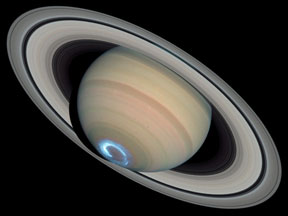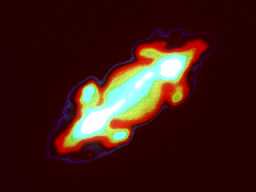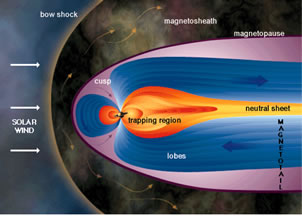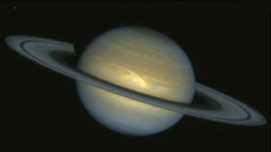This image is a radio map of Jupiter.
Click on image for full size
JPL
Radio Signals of Saturn
La plasmasfera de Saturno es bastante grande. La mayoría del plasma proviene de una
nube con forma de rosca (toroide) de material de Titán y otras lunas heladas.
Aparte de iones y electrones, la plasmasfera también contiene partículas muy energéticas, las cuales contribuyen con la radiación que hay en ese medio ambiente.
Las partículas entran en la plasmasfera desde la atmósfera, así como la
magnetocola. Las partículas abandonan la plasmasfera cuando caen muy lejos de las líneas de campos magnéticos, en los polos norte y sur. Cuando estas partículas chocan contra la atmósfera, dan orígen a la aurora.
You might also be interested in:

You may have seen a spider web catch bugs in it. Well, the Earth's magnetic field is kind of like a spider's web. It catches particles (protons and electrons) in it. The Earth's magnetic field catches
...more
Have you ever seen the Southern or Northern Lights? Did you know that other planets (besides Earth) have them too? Scientists call these cosmic light shows the "aurora". Saturn is one of the planets that
...more
Radio noises are a signature of activity within the magnetosphere. There are many kinds of radio waves in Jupiter's environment. These are: DAM DAM is the most intense of Jupiter's radio signals. It is
...more
Saturn's magnetosphere is not as big as Jupiter's, but it is still pretty big. It is big enough to hold all of Saturn's moons. The shape of the magnetosphere is affected by its size. The shape is also
...more
Saturn's plasmasphere is pretty big. Most of the plasma comes from the donut-shaped cloud of material from Titan and the other icy moons. Besides ions and electrons, the plasmasphere also contains very
...more
La plasmasfera de Saturno es bastante grande. La mayoría del plasma proviene de una nube con forma de rosca (toroide) de material de Titán y otras lunas heladas. Aparte de iones y electrones, la plasmasfera
...more
The most important motions in the atmosphere are winds. The major winds in Saturn's atmosphere are the zonal winds which are made of zones and belts. Zones and belts blow in opposite directions around
...more













